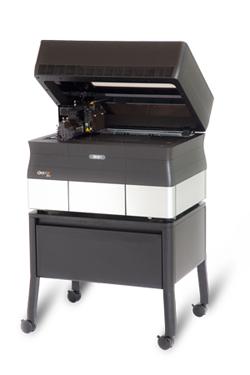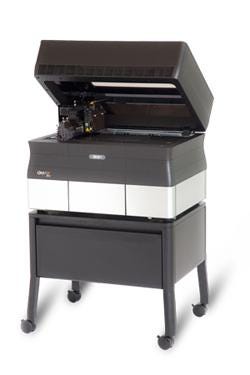3D Printer From Objet Serves Up Materials Mix
July 9, 2012

Objet Ltd. is taking strides to bring the price of its professional desktop 3D printer line down while pushing the range and functionality up with a new model that delivers support for an expanded palette of printing materials, including the company's clear transparent substance that simulates glass.
The Objet30 Pro, priced at $43,000, is positioned as the top-of-the-line desktop printer aimed squarely at industrial designers and engineering professionals looking for versatility around materials to produce parts prototypes. The base model in the series is priced starting at $19,900. "Our primary target is the professional design community looking to prototype a part that replicates what it will look like as a finished product," Bruce Bradshaw, Objet's director of marketing, told us.

What that means, Bradshaw explained, is that the professional engineer designing a medical device such as a catheter, for example, could 3D print a prototype to make sure it looks the way it's supposed to, or a designer working on a cellphone cover could 3D print the part to make sure it fits properly on the designated phone before the product heads off to manufacturing.
To support that level of realistic output, the Objet30 Pro can output at 28-micron print quality with a print platform of 8 x 10, making it well-suited to produce parts with the detail and accuracy around fit, form, and function that go hand-in-hand with functional prototyping. In addition, the breadth of materials choices is what really sets the Objet30 Pro apart from its competitors, according to Bradshaw.
On the materials front, the new model offers a choice of seven different materials and functional properties, opening up a range of possibilities for design applications. The unit supports four rigid, opaque materials for standard plastic simulation (what Bradshaw calls the Objet Vero Family in black, white, gray, and blue), along with the company's high-temperature material for heat-resistant static functional testing and its polypropylene-like material (called Objet DurusWhite), which enables the simulation of snap-fit parts. (Bradshaw described the white top piece of a Tic-Tac package as an example.)
Yet the real crowning achievement of the latest printer is its support for Objet's unique Objet VeroClear transparent material used to simulate PMMA glass. "The ability to print on the desktop level is really breakthrough," Bradshaw said. Prior to this release, he said support for any similar clear material would require a printer that cost upwards of $150,000 from Objet or an even higher pricetag from a competitor.
Interestingly, Objet's acquisition partner, Stratasys, announced a new printer recently in the low-cost range -- the Mojo, also aimed at design professionals and priced at $9,900. Bradshaw said there is a clear distinction between the two printers. The Mojo, he said, is addressing more entry-level needs for design professionals as well as educators, while the Objet30 Pro is at the opposite end of the spectrum.
"This is really for professionals dying to get into 3D printing, but couldn't so they were still doing outsourcing of 3D printing to service bureaus," he explained. "This gives them the versatility of all the different materials at a desktop-affordable price. It's the same category, but the opposite end."
Related posts:
About the Author(s)
You May Also Like
.jpg?width=300&auto=webp&quality=80&disable=upscale)


